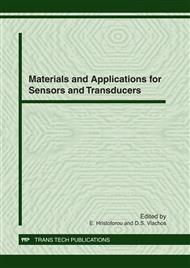p.1
p.5
p.9
p.13
p.18
p.23
p.28
p.33
p.37
Silver-Rutile UV Sensor Fabricated on Thermally Oxidized Titanium Foil
Abstract:
A UV-sensitive Schottky diode of Ag-rutile-Ti structure is fabricated on a thermally oxidized titanium chip. The junction is formed by the thermal evaporation of silver in vacuum and a subsequent controlled annealing process. Applying a biasing voltage of-300 mV, the reverse current of the fabricated silver-rutile-titanium structure increases five orders of magnitude under 50 µW/mm2 UV illumination ( λ=355 nm). The device is visible-blind and its operation is described based on the photoelectric mechanism in the carrier-depleted oxide layer. The dominance of the photoelectric, rather than photoconductive, mechanism along with the dense rutile layer are responsible for the fast transient times observed. The response and recovery times of the device are 800 µs and 7 ms, respectively.The device is stable and extremely cost effective.
Info:
Periodical:
Pages:
18-22
Citation:
Online since:
November 2011
Keywords:
Price:
Сopyright:
© 2012 Trans Tech Publications Ltd. All Rights Reserved
Share:
Citation:


